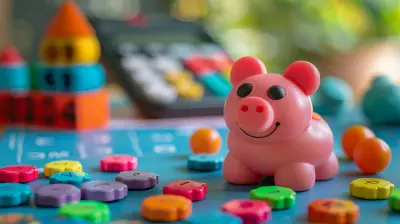How to Develop a Personalized Math Learning Plan for Every Student
4 May 2025
Math can be a tricky subject for many students. Some grasp concepts quickly, while others may struggle to keep up. That’s why a personalized math learning plan can make all the difference. Instead of treating every student the same, a customized approach helps cater to individual strengths, weaknesses, and learning styles.
So, how can you develop an effective math plan that ensures every student thrives? Let’s break it down step by step. 
Why Personalization Matters in Math
Not all students learn math in the same way. Some are visual learners, others prefer hands-on activities, and many need step-by-step explanations. A one-size-fits-all approach often leaves some students behind while others feel unchallenged.A personalized math learning plan helps:
- Address individual struggles and strengths
- Keep students engaged and motivated
- Build confidence in their math skills
- Ensure steady progress without frustration
Think of it like a GPS. If every student takes the same route, not all will reach their destination efficiently. A personalized plan is like a custom map, guiding them at their own pace while ensuring they stay on track. 
Step 1: Assess Students’ Current Math Skills
Before creating a learning plan, you need to know where each student stands. You wouldn't train for a marathon without knowing your current fitness level, right? The same goes for math.Ways to Assess Math Skills
- Diagnostic Tests: These pinpoint strengths and weaknesses so you can tailor instruction accordingly.- Observations: Pay attention to how students solve problems in class. Are they struggling with certain steps?
- One-on-One Conversations: Sometimes, students won’t openly say they’re struggling, so talking to them can uncover hidden challenges.
- Previous Performance Data: Past test scores and assignments can reveal patterns in their understanding.
Once you gather this data, you’ll have a clearer picture of what each student needs. 
Step 2: Set Clear and Achievable Goals
Now that you know where each student stands, it’s time to set goals. But vague goals like "get better at math" won’t cut it. Instead, use SMART goals—Specific, Measurable, Achievable, Relevant, and Time-bound.Example of a SMART Goal:
- Instead of “Improve multiplication skills,” try:"Solve 10 two-digit multiplication problems correctly within five minutes by the end of the month."
This approach keeps progress measurable and realistic, helping students stay motivated as they reach smaller milestones. 
Step 3: Identify Learning Styles
Understanding how a student learns best can make or break their math experience. There are three main learning styles:1. Visual Learners
- Prefer diagrams, charts, and step-by-step examples.- Benefit from watching video tutorials or using colorful math visuals.
2. Auditory Learners
- Learn better through discussions, explanations, and verbal instructions.- Thrive when concepts are explained out loud or through songs and rhymes.
3. Kinesthetic Learners
- Need hands-on activities, movement, and real-world applications.- Excel with manipulatives, math games, and interactive problem-solving.
By tailoring lessons based on these learning styles, students grasp concepts faster and retain information better.
Step 4: Choose the Right Resources and Tools
With so many math resources available, picking the right ones can be overwhelming. The key is to select tools that align with each student’s learning style and needs.Suggested Resources for a Personalized Plan:
- Workbooks & Printable Exercises: Great for students who need extra practice.- Online Learning Platforms: Websites like Khan Academy or IXL provide personalized exercises based on skill levels.
- Math Manipulatives: Tools like base ten blocks, fraction circles, or abacuses help kinesthetic learners.
- Gamified Learning Apps: Math games like Prodigy or Mathletics make learning fun and interactive.
- Video Tutorials: YouTube channels like Numberphile or Mathantics explain concepts visually and engagingly.
Using a mix of these resources keeps math lessons fresh and exciting.
Step 5: Create a Flexible Study Schedule
A rigid, one-size-fits-all schedule won’t work for personalized learning. Instead, the plan should be structured yet adaptable to accommodate different paces.Key Elements of an Effective Study Schedule:
1. Short, Focused Sessions – Rather than long, overwhelming lessons, aim for bite-sized 20-30 minute sessions.2. Daily Practice – Consistency is key. Even 10-15 minutes a day can reinforce concepts.
3. Mix of Activities – Rotate between exercises, hands-on activities, and digital tools to maintain engagement.
4. Built-in Review Time – Schedule regular check-ins to reinforce previous lessons before moving on.
5. Breaks and Rewards – Allow short breaks or small incentives after completing tasks to keep students motivated.
A flexible schedule reduces burnout and makes learning feel less like a chore.
Step 6: Track Progress and Adjust as Needed
A personalized learning plan isn’t static—it should evolve based on student progress. Regularly tracking their achievements helps identify what’s working and what needs adjustment.How to Track Progress Effectively:
- Progress Charts: Visualizing improvement with graphs or stickers can be motivating.- Weekly Check-Ins: Sit down with students to discuss their challenges and wins.
- Mini Quizzes: Short assessments help gauge understanding without the pressure of big tests.
- Parent & Teacher Feedback: Collaboration ensures well-rounded support for the student.
If something isn’t working, tweak the plan! Flexibility is key to making personalized learning successful.
Step 7: Encourage a Growth Mindset
Math anxiety is real, and many students give up because they think they’re just “bad at math.” A growth mindset shifts this perspective.Ways to Promote a Positive Mindset:
- Praise Effort, Not Just Results: Encourage students for trying, even if they make mistakes.- Use Encouraging Language: Replace “I can’t do this” with “I can’t do this yet.”
- Highlight Real-Life Math Success Stories: Show examples of people who struggled with math but succeeded.
- Teach Problem-Solving Persistence: Remind them that mistakes are part of learning.
When students believe they can improve, they’re more likely to push through challenges.
Conclusion
Personalized math learning plans are a game-changer. By assessing skills, setting clear goals, recognizing learning styles, and using the right resources, you can create a path that helps each student succeed.Remember, math isn’t about just solving numbers—it’s about building problem-solving skills, confidence, and a love for learning. With a tailored plan, every student has a chance to thrive, no matter their starting point.
So, ready to start building that personalized roadmap for success? Let’s make math less intimidating and more enjoyable—one student at a time!
all images in this post were generated using AI tools
Category:
Math SkillsAuthor:

Bethany Hudson
Discussion
rate this article
6 comments
Echo McHugh
Creating a personalized math learning plan can significantly enhance student engagement and mastery. Focus on individual strengths, learning styles, and goals to ensure each student thrives in their mathematical journey.
May 16, 2025 at 2:50 AM

Bethany Hudson
Thank you for your insightful comment! Personalizing math learning plans is indeed crucial for maximizing student engagement and success.
Kendall Pace
Personalized math learning plans cater to individual strengths and weaknesses, fostering engagement and confidence. Tailoring approaches can significantly enhance student understanding and overall performance.
May 13, 2025 at 8:15 PM

Bethany Hudson
Thank you for your insightful comment! I agree that personalized learning plans are crucial for addressing each student's unique needs and can greatly improve their confidence and performance in math.
Vera Pratt
Empowering students through personalized math learning plans inspires confidence and fosters growth. Every learner is unique, and tailoring education to their needs not only enhances understanding but ignites a lifelong love for learning. Let’s make math personal!
May 13, 2025 at 11:21 AM

Bethany Hudson
Thank you for your insightful comment! Personalizing math learning truly transforms education, helping each student thrive and cultivate a passion for learning. Let’s continue to prioritize individualized approaches in our teaching!
Henry Patel
Creating a personalized math learning plan requires understanding each student's unique strengths, challenges, and learning styles. Incorporating regular assessments and adaptive resources ensures that the plan evolves, fostering a supportive environment for effective math skill development.
May 8, 2025 at 11:13 AM

Bethany Hudson
Thank you for highlighting the importance of a tailored approach! Understanding individual strengths and challenges is key to fostering effective math development.
Idris Gomez
This article offers valuable insights into creating tailored math learning plans that cater to individual student needs. By emphasizing personalized strategies and adapting teaching methods, educators can significantly enhance student engagement and achievement in mathematics. A must-read for teachers!
May 6, 2025 at 7:53 PM

Bethany Hudson
Thank you for your thoughtful comment! I'm glad you found the insights valuable for enhancing student engagement and achievement in math. Happy teaching!
Cora Abbott
Creating a personalized math learning plan is like baking a cake — toss in some fractions, sprinkle with addition, and remember, no one likes a soggy bottom! Just ensure everyone's slice is perfectly tailored to their taste. Happy baking... I mean learning!
May 5, 2025 at 3:00 AM

Bethany Hudson
I love the cake analogy! Just like baking, a personalized math plan incorporates individual tastes and strengths to create a recipe for success. Happy learning!
MORE POSTS

Virtual Teamwork: Collaborative Learning in Digital Classrooms

How to Use Visual Aids to Help Students with Learning Disabilities

Leveraging Technology to Boost Your Learning and Development

How to Help Students Recognize and Correct Math Mistakes

The Role of University Research in Advancing Society